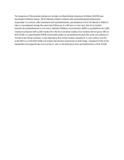Response of Plasmodium falciparum to dihydrofolate reductase inhibitors in Malindi, Kenya

View/
Date
1985Author
Spencer, Harrison C
Watkins, William W
Sixsmith, David G
Koech, Davy K
Language
enMetadata
Show full item recordAbstract
The response of Plasmodium falciparum isolates to dihydrofolate reductase inhibitors (DHFRI) was examined in Malindi, Kenya. All 20 infected children treated with pyrimethamine/sulphadoxine responded. In contrast, after treatment with pyrimethamine, parasitaemia in 9 of 14 infections failed to clear or recrudesced during the seven-day follow-up. In a 48-hour in vitro test, five of six isolates resistant to pyrimethamine in vivo had a minimal inhibitory concentration (MIC) to pyrimethamine ⩾300 nmoles/l compared with ⩽100 nmoles/l for the four sensitive isolates; four isolates did not grow. MIC to M-B 35769, an experimental DHFRI structurally similar to pyrimethamine were the same (six isolates) or 10-fold lower (three isolates). In the laboratory four of five isolates adapted to in vitro culture had the same MICs as in the field while one isolate became less responsive to both drugs. Cycloguanil (the active metabolite of proguanil) was more active in vitro in the laboratory than pyrimethamine or M-B 35769.
Citation
Oxford Journals Medicine & Health Transactions RSTMH Volume 80, Issue 2 Pp. 201-203Publisher
University of Nairobi
Collections
- Faculty of Health Sciences (FHS) [10378]
